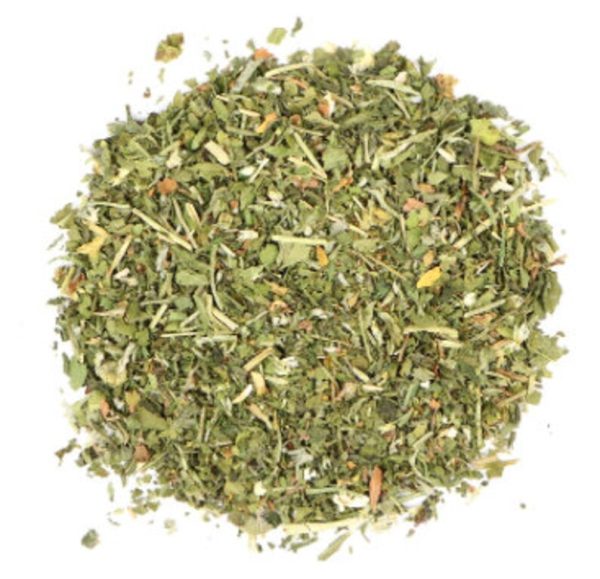Latin Name: Tanacetum parthenium syn. Aphanostephus pinulensis, Chrysanthemum parthenium, Parthenium matricaria, Pyrethrum parthenium. Plant Family: Asteraceae (daisies) Other Names: Featherfew, Featherfoil, Flirtwort, Febrifuge Plant, Nosebleed, Midsummer Daisy, Altamisa, Wermod Wen and Bachelor’s Buttons. The name stems from the Latin word febrifugia, “fever reducer.” Also known as “featherfew,” because of its feathery leaves.
| Price | £8.71 |
| Weight: | 50 g |
Description
Identity & Location:
- While Feverfew has a bitter taste (similar to chamomile), when mixed with honey to make a healthy herbal tea, the flavour is actually quite palatable! It is a short, bushy, aromatic perennial that grows 0.3–1 m in height.
- Its yellow-green leaves are usually less than 8 cm in length, almost hairless, and pinnate–bipinnate (chrysanthemum-like).
- Its yellow flowers bloom from July to October, are about 2 cm in diameter. They resemble those of chamomile (Matricaria chamomilla), for which they are sometimes confused, and have a single layer of white outer-ray florets.
Native to the Balkan Peninsula, feverfew is now found in Australia, Europe, China, Japan, and North Africa. In the mid-19th century, feverfew was introduced in the United States. The plant grows along roadsides, fields, waste areas, and along the borders of woods.
Properties & Pharmacology:
- Anti-Inflammatory
- Antihistamine
- Antibacterial
- Chemotherapeutic
- Emmenagogue
- Anticancer activity
- Migraine headache, prophylactic
Uses:
- It is is promoted for fevers, headaches, and arthritis; topically (applied to the skin)
- It’s promoted for toothache
- And as an antiseptic and insecticide.
- Feverfew has been called “medieval aspirin” or “aspirin of the 18th century.”
- The feverfew herb has a long history of use in traditional and folk medicine, especially among Greek and early European herbalists.
- Feverfew has also been used for psoriasis, allergies, asthma, tinnitus, dizziness, nausea, and vomiting.
- The ancient Greeks called the herb “Parthenium,” supposedly because it was used medicinally to save the life of someone who had fallen from the Parthenon during its construction in the 5th century BC.
- The first-century Greek physician Dioscorides used feverfew as an antipyretic.
The plant has been used to treat
- arthritis,
- asthma,
- constipation,
- dermatitis,
- earache,
- fever,
- headache,
- inflammatory conditions, insect bites,
- labour,
- menstrual disorders,
- potential miscarriage,
- psoriasis,
- spasms,
- stomach ache,
- swelling,
- tinnitus,
- toothache,
- vertigo, and
- worms.
In Central and South America, the plant has been used to treat a variety of disorders. The Kallaway Indians of the Andes Mountains value its use for treating colic, kidney pain, morning sickness, and stomach ache.
Costa Ricans use a decoction of the herb to aid digestion, as a cardiotonic, an emmenagogue, and as an enema for worms.
In Mexico, it is used as an antispasmodic and as a tonic to regulate menstruation. In Venezuela, it is used for treating earaches.
Cautions:
- Feverfew may alter the effects of some prescription and non-prescription medications.
- If you are currently being treated with blood-thinning medications (such as aspirin and warfarin) you should consult your health care provider before taking this herb.
- No studies of chronic toxicity have been performed on the plant and the safety of long-term use has not been established.
Pregnant women should not use the plant because the leaves have been shown to possess potential emmenagogue activity. It is not recommended for lactating mothers or for use in children.

Review Feverfew 50g.